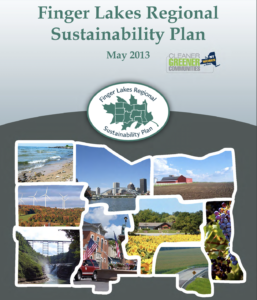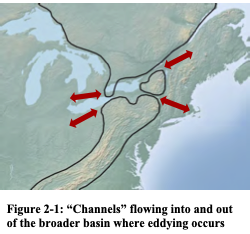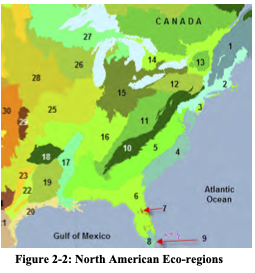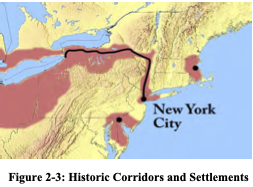 Though the nine counties addressed in this Plan are called “The Finger Lakes Region,” the area does not include all of the Finger Lakes, and the three western counties are actually in the Genesee Valley. Therefore, this region has sometimes been called the “Genesee-Finger Lakes Region.”
Though the nine counties addressed in this Plan are called “The Finger Lakes Region,” the area does not include all of the Finger Lakes, and the three western counties are actually in the Genesee Valley. Therefore, this region has sometimes been called the “Genesee-Finger Lakes Region.”
All of the waters of the Great Lakes drain through Lake Ontario on their way to the Atlantic Ocean. Lake Ontario is the lowest of the Great Lakes. All the rest sit within the same large plain with only a small change in elevation between Lake Superior and Lake Michigan. Lake Ontario lies almost 300 feet lower because of the great drop at Niagara Falls.
The region is part of a vast complex of bedrock that covers much of Canada and the northern United States. On top of this bedrock, two ancient seas formed. Each of these seas was filled when huge mountain ranges rose to the east and eroded down into them. Deposition of the skeletal remains of millions of sea creatures living in the warm shallow waters of these seas created the limestone layers throughout the region. Meanwhile, the material that eroded from the mountains formed the characteristic layers of shale. The limestone helps to buffer the pH of the normally acidic soils, and the shale provides excellent drainage. Both of these factors account for the region’s prime agricultural soils.
These seas and mountains were followed by at least four periods of glaciation, forming the existing landscape. Glaciers carved the Finger Lakes, the Great Lakes and improved the drainage of the soil. Since the path of the St. Lawrence River was under ice, melt water from the retreating glacier forced the water to run through the gap between the Adirondacks and the Catskills into the Hudson River, carving what is now the Mohawk Valley.
The coastal plain of Lake Ontario opens into a broad area between three narrow entrances: the Mohawk and St. Lawrence River Valleys to the east, and the narrow corridor between Lake Erie and the Appalachian Mountains to the west.
The Mohawk Valley and the coastal plain of Lake Ontario form a crucial link between the elevated plain of the Great Lakes and the Hudson Valley lowlands. This passage has determined the movement and growth of plants, animals, people, and ideas for thousands of years – a central element to the Story of the Finger Lakes.
People have long used this area of low-elevation to cross the mountains that separate the eastern seaboard from the interior of the continent. It is the easiest crossing north of the Carolinas. Native trails, canals, railroads and modern highways all have followed the path carved by the glaciers and their melt water. However, it is more than a simple corridor. Lake Ontario is in fact a slowing, settling pond between the Niagara River Gorge and the St. Lawrence River. (Figure 2-1) In any waterway, where the channel flattens and spreads out, resources collect, things take root, and diverse species are attracted and can get established.

This rich pocket of soils supported a large and agriculturally productive native population up through the time of the Revolutionary War. There were a few comparable pockets of good soil along the eastern seaboard but they were claimed early on by wealthy plantation owners, royal land grants, or corporations. The majority of good soils on the continent, in the upper Midwest and throughout the Great Plains, remained out of reach during the Colonial period. So the coastal plain of Lake Ontario represented the first large expanse of high quality soils available to common people in the newly established United States. These extensive fertile farmlands enabled the growth of a prosperous farming middle class much like the one that grew soon after in Ohio and the Upper Midwest. This was the first large expanse of farmland settled by truly free Europeans who were neither serfs nor serving under a monarch.
 The eco-regions, represented on Figure 2-2, are determined by the soils, elevation, and climate of a region, which determine what can grow and live there. The dark green eco-region of the Great Lakes (labeled 15 on Figure 2-2) reaches a narrow arm into this region where it meets the Allegany Highlands, an extension of the Appalachians. It is as though the Midwest reaches an arm into the eastern highlands. An alternative analysis describes this eco-region as a western extension of the New York lowlands. In either case it is a meeting place.
The eco-regions, represented on Figure 2-2, are determined by the soils, elevation, and climate of a region, which determine what can grow and live there. The dark green eco-region of the Great Lakes (labeled 15 on Figure 2-2) reaches a narrow arm into this region where it meets the Allegany Highlands, an extension of the Appalachians. It is as though the Midwest reaches an arm into the eastern highlands. An alternative analysis describes this eco-region as a western extension of the New York lowlands. In either case it is a meeting place.
The Five (later six) Nations of the Iroquois called themselves the Haudenosaunee—People of the Longhouse—because they saw the Ontario Lake plain and the Mohawk Valley as one great Longhouse that they lived within. Their Longhouse was the gateway to the Great Lakes, the Midwest and the drainage of the Mississippi. Due to its strategic location, the Longhouse was right in the middle of the European struggle, especially between the British and the French, for the furs and other riches of the “New World”. It continued to be strategically important during both the American Revolution and the War of 1812.
 The Erie Canal and the Mohawk Trail followed the same path (Figure 2-3), the constriction in the water transportation routes between the eastern seaboard and the Great Lakes/Mississippi Valley. Due to its inherent attractiveness, people not only traveled through, they settled and took root. Population grew rapidly during the Erie Canal era. This fertile open space adjacent to the main course of flow allowed resources, people, and ideas to settle out and take root, seeding many new ideas and ways of doing things. Wheat production, water- driven milling capacity, and the development of water transportation to get products to market in New York City, meant that Rochester quickly took off as the Flour City and one of the new country’s first industrial boom towns.
The Erie Canal and the Mohawk Trail followed the same path (Figure 2-3), the constriction in the water transportation routes between the eastern seaboard and the Great Lakes/Mississippi Valley. Due to its inherent attractiveness, people not only traveled through, they settled and took root. Population grew rapidly during the Erie Canal era. This fertile open space adjacent to the main course of flow allowed resources, people, and ideas to settle out and take root, seeding many new ideas and ways of doing things. Wheat production, water- driven milling capacity, and the development of water transportation to get products to market in New York City, meant that Rochester quickly took off as the Flour City and one of the new country’s first industrial boom towns.
As The Ohio Valley surpassed the Genesee Valley in the production of wheat and other farm products, the Flour City became the Flower City. A thriving nursery industry supplied cold tolerant fruits and flowers for local use, as well as to the Upper Midwest and cold growing areas in general. Today’s apple and grape industries are based in the breeding of apple and grape varieties, particularly seedless white table grapes named after regional towns like Himrod and Interlaken. Many of the varieties bred here are well known to home gardens all over the country.
When the Erie Canal was developed, there were no civil engineers in this country and the engineering profession was in its infancy. Learning from the canal builders of England and Europe, the Canal’s builders developed a host of new techniques to meet the challenges presented by the monumental task that the canal represented. Some engineering techniques and methodologies upon which our society is built were developed for the Erie Canal. The success of the Erie Canal led to the building of many other projects, including the much larger and longer St. Lawrence Seaway. In a similar way, Rochester laid the pattern for water-based commerce that drove the development of the industrial cities of the Upper Midwest, cities like Chicago and Detroit. Unlike older cities, even those of the East Coast, these new industrial cities were not organized on a medieval pattern of Church/Central Plaza. They were organized around transportation and commerce, a new pattern that has come to dominate urban development.
The patterns and organizations of farms and farm communities of the Upper Midwest were also first developed here. The large flat fields and abundant harvests called for new strategies for growing and distribution. Also, this region was the first where Europeans settled and farmed as free people rather than serfs, slaves, indentured servants, or the subjects of a sovereign of some kind. They needed to invent new ways to organize and govern themselves. Innovations like The Grange (oldest American agricultural advocacy group), farm co-ops, and home rule were the result.
In many histories, this region is known as the “Burned Over District” for the great religious revivals that swept through during the antebellum period known as the “Great Awakening”. The large populations from diverse places that streamed into this region found it almost empty of traditional religious institutions to fill their spiritual needs. This led to a period of ferment and experimentation that fostered a host of new sects and religions including Seventh Day Adventism, Mormonism, Spiritualism, as well as revival meetings and circuit rider preachers. These religious revivals led to a continuous conversation about grace, salvation, good works, and free will that laid the basis for many of the social movements that were to follow. They also developed the institutions that would follow the settlers west.
Long before European contact, the Five (later six) Nations of the Iroquois established the first democratic confederacy in the Americas, including complete women’s suffrage. Having come through a long period of terrible and unremitting violence, the Five Nations chose to lay down their arms and form a confederacy. The wampum belt of the Great Law depicts an organization that is at once political, social, and cosmological. The pattern includes the Elder Brothers (Seneca, Mohawk), the Younger Brothers (Oneida, Cayuga), the Fire Keeper in the center (Onondaga), and the Clan Mothers. The bundle of five arrows symbolizes the collective insight that while one arrow is easily broken, a bundle cannot be broken. The confederacy is represented by the longhouse, and the peace by the Tree of Peace on whose top sits the eagle who watches for danger.
Franklin and Jefferson were both aware of the Iroquois system. Franklin wrote, “It would be a strange thing if Six Nations of ignorant savages should be capable of forming a scheme for such an union, and be able to execute it in such a manner as that it has subsisted ages and appears indissoluble; and yet that a like union should be impracticable for ten or a dozen English colonies, to whom it is more necessary and must be more advantageous, and who cannot be supposed to want an equal understanding of their interests.”
In the new constitution, the Elder and Younger Brothers became the Senate and the House, the fire keeper the President, and the Clan Mothers, the Judiciary, with the power to remove any leaders. The Eagle atop the Tree of Peace and the bundle of five arrows became the eagle clutching thirteen arrows on the great seal of the U.S. and the famous first words “We the People” derives from the first lines of the Iroquois Thanksgiving Address.
These ideals of equality and freedom reappeared repeatedly in the social movements that grew in the region: abolitionism, women’s rights, even Memorial Day which commemorates the common soldier. These freedom movements grew directly out of the interaction between the great Iroquois tradition and the moral questioning of the Great Awakening, and they changed the world. Women involved in the movement for women’s rights took inspiration from their Iroquois friends, who at that time represented the only role models for strong women in central roles of social and political leadership. Lucrecia Mott originally came to the region with her husband to witness the constitutional convention of the Senecas in 1848.